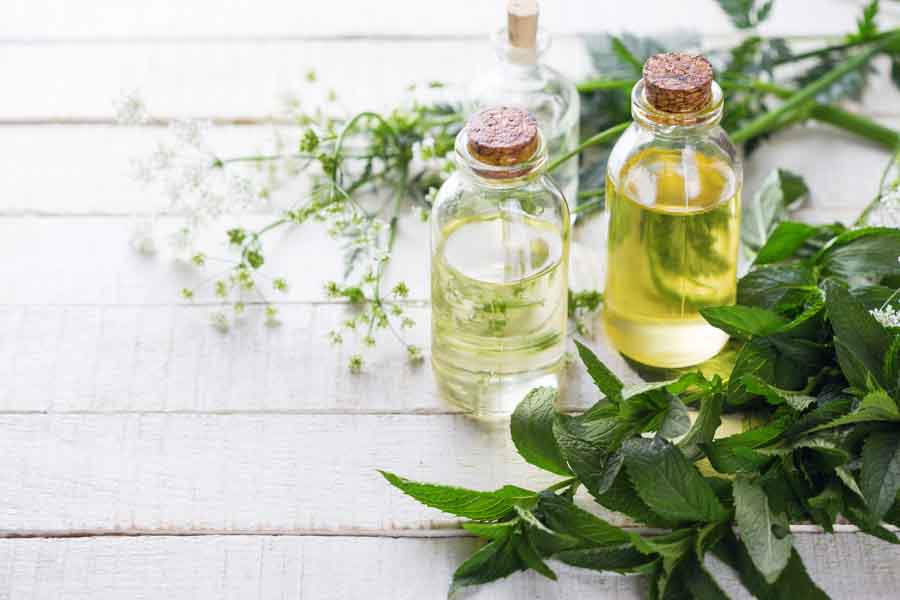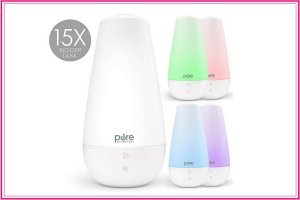
Peppermint oil is one of the more popular oils on the market. It is used in a whole host of beauty and food products around the world.
But what exactly is peppermint oil? What are its origins? And how can we get the best out of this unassuming yet potent oil?
Join us as we take an in-depth look at peppermint essential oil…
The origins of peppermint oil
Peppermint essential oil is often considered one of the most-loved of all the oils after, other big names like lavender and rose. Its reputation as a multi-purpose healer might precede it, but is actually has a long and illustrious history.
One of the first references to peppermint oil is actually in Greek mythology when the god Pluto turned a nymph named Mentha into a sprig of peppermint. The great god had fallen in love with her, and he wanted to immortalize her so that others would appreciate Mentha as well.
Aside from Greek mythology, peppermint is also referenced in European herbal medicine, as well as in ancient Chinese and Japanese medicine. There are even references to peppermint oil as far back as 1,000 BC and the oil was also discovered inside the tombs of several ancient Egyptian pharaohs.
What is peppermint oil?
Most people don’t realize that peppermint oil is actually a hybrid of two separate herb species, namely spearmint and water mint. As such, the main composition of peppermint oil is about 30-45% menthol and 10-30% menthone.
What are some of the benefits?
Peppermint oil is often best known for its fresh minty smell, but it is actually one of the most versatile essential oils that you can find, and has a plethora of uses that are not just limited to any one area.
One reason for this is down to the cooling effects that peppermint oil has as well as its strong properties as an antimicrobial. This means that it can be used topically to soothe and calm inflammation, can help to freshen odor like bad breath, and can even relieve digestive problems.
Medicinally, peppermint oil is often used as an anti-nausea medication and as a digestive healer thanks to its anti-spasm properties.
Specific Benefits of Peppermint oil

1.) As a way to soothe sore muscles
Peppermint essential oil is known for being a natural relaxant as well as having a numbing effect that makes it a natural painkiller. As such it is great when applied to sore muscles and can also work on things such as a tension headaches where tired and cramping muscles may be involved. To soothe muscles, simply rub a few drops of peppermint oil topically on the painful or inflamed area.
Related: 9 Essential Oils for Sore Muscles / Muscle Pain
2.) As an insect repellent
Insects absolutely hate peppermint oil because of its menthol undertones and as such it makes a great bug spray. You can mix it with a carrier oil and then spray it lightly on skin to keep bugs at bay or make a household insect repellant that you can use in a diffuser.
Related: 7 Essential Oils for Bee Stings, Bug Bites & More
3.) As a support for weight loss
Peppermint oil is a natural appetite suppressant, although many people fail to realize this. Not only does it curb our appetite but it also makes us feel fuller for longer after a meal, and thus can help us to curb our cravings and subsequently lose any bothersome weight. A few drops rubbed on your chest before you sit down for a meal should be enough to do the trick.
4.) As a pick-me-up
If you want to improve your mental clarity or just need something to perk you up after a long day, peppermint oil is a great remedy. You can use a diffuser or simply inhale the vapors of a few drops from a bottle, but peppermint oil is guaranteed to help you feel more focused and awake due to its naturally stimulating properties.
Related: 14 Uplifting Essential Oils for Energy & Wakefulness
5.) As a shampoo
In keeping with the theme of stimulation, peppermint oil can either be added to your regular shampoo or used after it and massaged into your scalp. It will stimulate your hair follicles and as it is an antiseptic will also work at treating dandruff or even parasites like hair lice.
6.) As an anti-allergy remedy
Peppermint oil naturally relaxes muscles, including those in the nose and throat, so if you are suffering from allergies such as hay fever then it can help to keep nasal passages clear of mucus. Using it in a diffuser is a great idea here along with another oil like eucalyptus oil.
Related: 9 Essential Oils for Allergies
7.) As an anti-rash cream
If you are stuck with a bothersome rash or skin irritation then peppermint oil can come to your rescue. It reduces the feeling of itchiness and irritation due to its cooling and soothing effects.
8.) As a fever reducer
Peppermint oil is naturally cooling and can be used to bring down a temperature. Mixed with a carrier oil like coconut oil it can be rubbed on the skin to provide immediate relief.
9.) As a way of treating sunburn
If you are suffering from painful sunburn then peppermint oil will not only soothe your skin but will also cool you down and moisturize any tender areas.
Related: 7 Essential Oil Based Remedies for Sunburns
10.) As a way of improving oral hygiene
Peppermint oil has been used for years as a way of freshening bad breath, and it can be made into a natural mouthwash. It is also known to promote oral health and reduce cavities and gum disease.
Related: How to Make a Healthy Mouthwash using Essential Oils
11.) As a digestive aid
If you suffer from gut related issues like irritable bowel syndrome, bloating, or excess gas, then peppermint oil can soothe discomfort and work as a cure for indigestion. Peppermint oil is an antispasmodic, and it can also work to reduce cramping in the colon and relax muscles in the gut.
12.) As an anti nausea medication
Peppermint oil is known to reduce the feelings of nausea and can be used to treat anything from motion sickness to nausea caused by a bad diet or infection. You can add a drop of peppermint oil to water and take it orally, or you can use it in a diffuser to dispel feelings of sickness.
Related: 5 EO Remedies for Nausea, Vomiting & Upset Stomach
13.) As a headache reliever
If you suffer from headaches then peppermint oil can be a great way to naturally soothe the pain away. Peppermint oil improves circulation and works as a relaxant that stops muscles from cramping and loosens tension. As such, peppermint oil can decrease pain from a headache if you rub a few drops directly onto your temples.
Related: 7 Essential Oils for Headaches & Migraines
14.) As a skin balm
Peppermint oil has a calming effect when applied to the skin and is great if you suffer from any kind of skin inflammation. This is because it cools and reduces the effects of rashes or puffiness, and it can work wonders on conditions such as psoriasis or eczema. Mix a few drops of peppermint oil with your regular body location or apply it sparingly directly to the skin.
15.) As a study aid
Peppermint oil increases blood flow, and as such is said to improve concentration and make us naturally more alert. With that in mind, you can take it orally with one drop under your tongue if you need to study or want to feel more focused.
5 Essential Oils that Promote Focus and Concentration
14 Uplifting Essential Oils for Energy & Wakefulness
Things to keep in mind when using peppermint oil

Peppermint oil is a fabulous oil that can be used for a whole host of issues, but we still need to be mindful of how and when we ingest it.
Too much peppermint oil can have side effects like heartburn, headaches, and mouth sores. For that reason, make sure that you are only taking a few drops orally at a time. Though it can be tempting to add more!
Also note that peppermint oil can reduce the way in which iron is absorbed by the body if you take iron supplements at the same time as ingesting peppermint oil. For this reason make sure that you leave a gap of around 3-4 hours between taking peppermint oil and iron.
Peppermint Oil Based Recipes

Peppermint Oil Enhanced DIY Shampoo
If you are looking for an easy peppermint oil recipe then this one for a natural peppermint oil shampoo is a great one to start with.
The benefits of peppermint oil for hair are many, and as it works as an antiseptic it is great for treating dandruff. The act of rubbing it on your scalp if you have a shower in the morning will also help to wake you up and inhaling the vapors of peppermint oil will leave you energized for the day ahead.
There is a reason that peppermint oil is used in lots of hair products, quite simply it is known to have moisturizing properties that will nourish brittle and damaged hair and it also stimulates the scalp and can treat hair loss or thinning hair.
With all of that in mind, a peppermint oil shampoo is an amazing and versatile product to add to your bathroom.
For a healthy DIY shampoo you will need:
- 4 oz of water
- 2 oz liquid castile soap
- 2 tsp fractionated coconut oil
- 1/8 tsp peppermint essential oil
- 1/8 tsp tea tree essential oil
- 1 tsp vegetable glycerin– this is to add body to the shampoo if you want it to feel like a ‘normal’ shampoo. If you are happy with just the base ingredients then leave this out.
Directions:
Mix all the ingredients together in a glass bowl and then transfer to a glass container. You will notice that the ingredients separate after each use which is normal, just give your container a good shake to mix them together again.
Tip: One of the best things about this shampoo is the smell of the peppermint oil which has a revitalizing effect, but if you want to keep things fresh then can add other oils to the mix as well to change up the scent. Some nice picks that work well with peppermint oil are a few drops of rosemary oil, lemon oil, or any of your other favorite oils.
Peppermint Oil Sunburn Reliever Recipe

When it comes to this handy little recipe, note that this is a sunburn reliever and not a sunscreen. It won’t do anything to keep you from getting burned, so make sure that you use your normal sunscreen protection and take care when you are out and about in the sun. If you do end up getting burned however, then this is a fantastic natural remedy that you will have your skin feeling better in no time. Keep it in a cool place and spray it on when it is still cold for even greater relief.
Two of the three main ingredients here are aloe vera and coconut oil which will rehydrate your sore skin and put back some of the moisture you have lost. The third is the mighty peppermint oil which will soothe any redness and puffy skin and work to get rid of the inflammation caused by sunburn. Perfect in the summer!
To make this sunburn reliever you will need:
Ingredients:
- ½ cup of aloe vera juice
- ¼ cup of coconut oil
- 10 drops of peppermint oil
- 5 drops of lavender oil
Directions:
- Melt the coconut oil until it is liquid and then leave to cool for a few minutes.
- Add the aloe vera juice and mix until the two are well combined.
- Add the oils and mix well.
- Pour into a spray bottle and make sure to store in a cool place.
- Spray directy onto skin as needed.
Tip: Lavender oil is mixed with the peppermint oil here as it has natural skin-soothing properties and works well when paired with peppermint oil. However, you can play around with other oils as well, and could even add 5 drops of another oil to the mix if you so desire. What’s important is the keep the base recipe of coconut oil, aloe vera juice, and peppermint oil the same, but apart from that feel free to experiment and have fun!
Conclusion

Hopefully you’ve found this article helpful!
If you have any questions, comments or recommendations of your own regarding peppermint essential oil please let us know in the comments!











1 thought on “10 Benefits and Uses of Peppermint Essential Oil (Plus Mixtures & Application Tips)”
I think that it would be nice to get some peppermint recipes. I think it would be nice to get some help in getting my syrup peppermint flavored. I think it would be nice to get some help working these recipes.